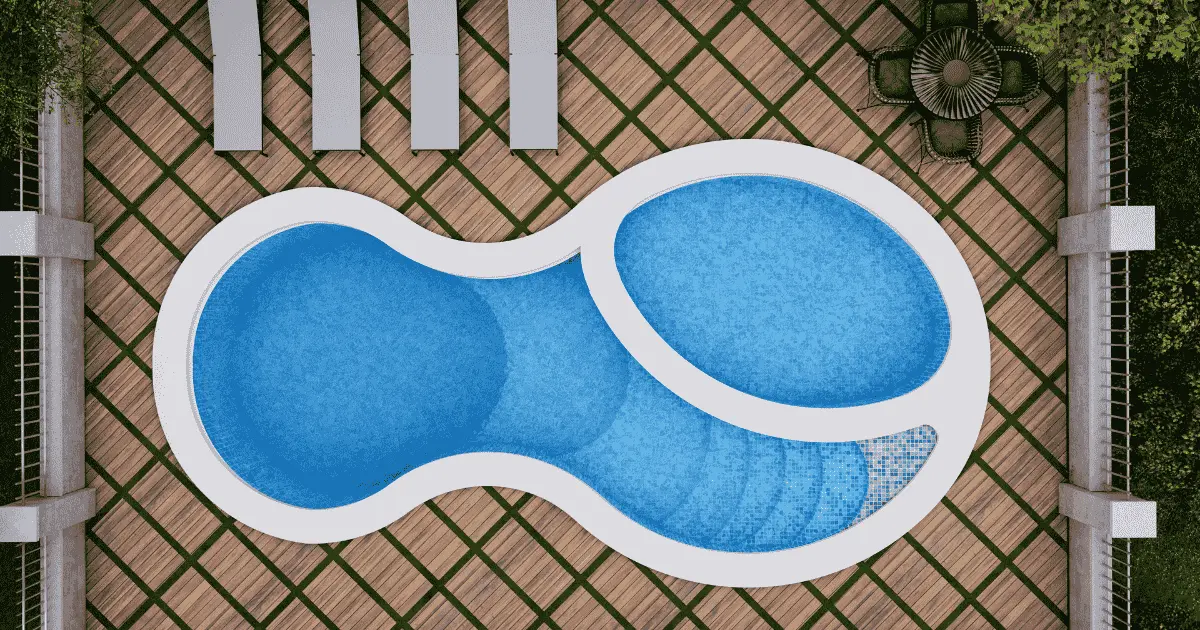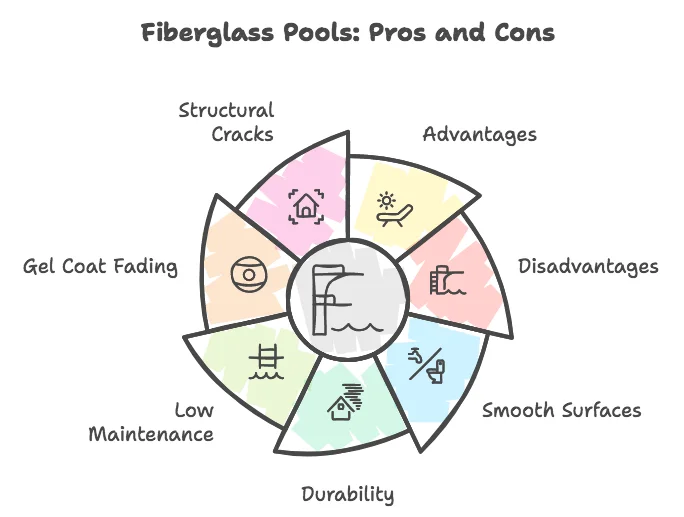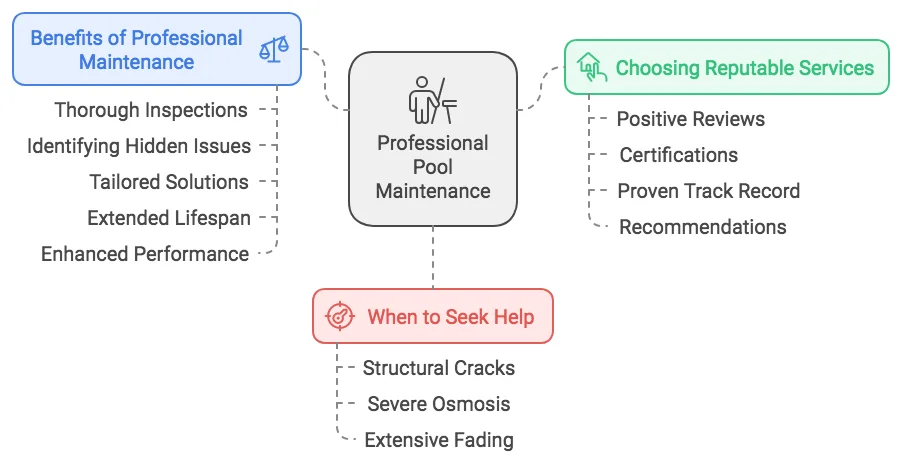CALL US NOW!
+91-213-666-0027
CALL US NOW!
+91-213-666-0027
Top 10 Fiberglass Pool Problems And Solutions
- Home
- Top 10 Fiberglass Pool Problems And Solutions

Introduction
Fiberglass pools have become increasingly popular among homeowners and pool enthusiasts due to their smooth surfaces, durability, and relatively low maintenance requirements. However, like any other types of pool, fiberglass pools are not without their problems. Fiberglass Pool Problems And Solutions include gel coat fading to structural cracks, these issues can hinder your enjoyment and the longevity of your pool.
This aims to guide homeowners, pool enthusiasts, and maintenance professionals through the common problems associated with fiberglass pools and offer practical solutions to ensure your pool remains in top-notch condition. By understanding these issues and how to address them, you can extend the lifespan of your pool and enjoy crystal-clear waters for years to come.
Table of Contents
Common Fiberglass Pool Problems
Gel Coat Fading and Discoloration
One of the most common issues fiberglass pool owners face is the fading and discoloration of the gel coat. This problem is often caused by prolonged exposure to UV rays, improper water chemistry, or the use of harsh chemicals. Signs to look out for include a chalky appearance, dullness, or uneven coloring on the pool surface.
The impact of gel coat fading goes beyond aesthetics; it can also weaken the pool’s surface over time. Regularly checking the water’s pH and chlorine levels, using pool covers, and avoiding abrasive cleaning agents can help mitigate this issue.
Structural Cracks
Structural cracks in fiberglass pools can be alarming. They often result from ground movement, poor installation, or the use of substandard materials. These cracks are typically visible on the pool walls or floor and can lead to water leakage if not addressed promptly.
While minor cracks might not immediately affect the pool’s functionality, they can worsen over time, leading to significant repair costs. Regular inspections and addressing any shifts in the pool’s foundation can prevent structural damage in the long run.
Bulging
Bulging occurs when sections of the pool’s surface appear swollen or uneven. This issue is usually caused by improper backfilling during installation or ground pressure exerted on the pool shell. Bulges can compromise the pool’s structural integrity and overall appearance.
To avoid bulging, ensure that the installation process is carried out by experienced professionals who use appropriate backfilling materials. Regularly inspecting the pool surroundings for any changes in soil pressure can also help prevent this problem.
Osmosis and Blistering
Osmosis and blistering are phenomena where water penetrates the fiberglass layers, causing bubbles or blisters on the pool surface. Poor-quality gel coats or prolonged water exposure often lead to this issue. Blisters can range from small, barely noticeable bumps to larger, more problematic protrusions.

Addressing osmosis and blistering requires professional intervention. Preventative measures include using high-quality gel coats and maintaining balanced water chemistry to reduce the risk of water infiltration.
Spider Cracks
Spider cracks are tiny, web-like cracks that often appear on the surface of fiberglass pools. These can result from manufacturing defects, impact damage, or stress during transportation and installation. While they may seem cosmetic, spider cracks can expand and cause more severe damage if left untreated.
Regularly inspecting the pool surface for any signs of spider cracks and addressing them promptly with professional repair services can prevent further complications.
Water Chemistry Imbalance
Maintaining proper water chemistry is crucial for the longevity of any pool, and fiberglass pools are no exception. Imbalanced water chemistry can lead to various issues, including algae growth, scale buildup, and surface staining. Common indicators of water chemistry imbalance include cloudy water, unusual odors, or visible buildup on the pool surface.
Regularly testing and adjusting the water’s pH, alkalinity, and chlorine levels can help maintain a healthy pool environment and prevent chemical-related damage.
Understanding the Underlying Causes
Poor Installation
Many fiberglass pool problems stem from poor installation practices. Incorrect leveling, inadequate backfilling, and improper plumbing can all contribute to structural issues. Ensuring that the installation is carried out by experienced professionals who follow industry standards is crucial for avoiding future problems.
Environmental Factors
Environmental factors such as soil conditions, ground movement, and weather patterns can significantly impact the integrity of fiberglass pools. For example, areas prone to heavy rainfall or seismic activity may require additional precautions during installation to prevent ground-related issues.
Understanding the environmental conditions of your pool’s location and taking appropriate measures can help mitigate potential risks.
Low-Quality Materials
Using substandard materials during the manufacturing or installation process can lead to various fiberglass pool problems. Low-quality gel coats, resins, and fiberglass layers are more susceptible to damage and wear over time.
Investing in high-quality materials and reputable manufacturers can ensure the durability and longevity of your pool.
Effective Maintenance Tips
Regular Cleaning and Inspection
Routine cleaning and inspections are essential for maintaining a fiberglass pool. Regularly remove debris, brush the pool walls and floor, clean the heating systems, cleaning the slides and vacuum the pool to prevent dirt buildup and cleaning extra features in your pools. Inspections should focus on identifying any signs of damage, discoloration, or algae growth.
Implementing a weekly maintenance schedule can help keep your pool in pristine condition.
Water Chemistry Management
Proper water chemistry management is vital for preventing many common pool problems. Regularly test the water’s pH, alkalinity, and (salt water) chlorine levels using reliable testing kits. Adjust the chemical levels accordingly to maintain a balanced and safe swimming environment.
Consider using automatic chemical feeders or hiring a professional service to ensure consistent water quality.
Addressing Minor Issues Promptly
Addressing minor issues promptly can prevent them from escalating into major problems. For example, small cracks or discoloration spots should be repaired as soon as they are detected. Timely intervention can save you from costly repairs and prolong the life of your pool.
Professional Solutions
When to Seek Professional Help
While some maintenance tasks can be handled by homeowners, certain issues require professional expertise. Significant structural cracks, severe osmosis, and extensive fading should be addressed by experienced pool technicians. Professionals have the knowledge and tools to diagnose and repair complex problems efficiently.
Choosing Reputable Services
Selecting reputable pool maintenance and repair services is crucial for ensuring quality work. Look for companies with positive reviews, certifications, and a proven track record in fiberglass pool maintenance. Asking for recommendations from other pool owners can also help you find trustworthy professionals.
Benefits of Professional Maintenance
Professional maintenance services offer several advantages. They can provide thorough inspections, identify hidden issues, and offer tailored solutions for your pool. Regular professional maintenance can also extend the lifespan of your pool and enhance its overall performance.
Future-Proofing Your Fiberglass Pool
Selecting High-Quality Materials
When it comes to repairs and renovations, always opt for high-quality materials. Using superior gel coats, resins, and fiberglass layers can prevent future problems and ensure the longevity of your pool. High-quality materials are more resistant to environmental factors and wear, providing better protection for your investment.

Proactive Maintenance
Proactive maintenance involves taking preventive measures to avoid potential problems. Regularly inspect your pool, maintain balanced water chemistry, and address minor issues promptly. Proactive maintenance can save you from costly repairs and ensure your pool remains in top condition.
Long-Term Planning
Consider long-term planning for your fiberglass pool. Regularly update your maintenance schedule, invest in high-quality materials, and budget for professional maintenance services. Long-term planning can help you enjoy a beautiful and functional pool for years to come.
Conclusion: Fiberglass Pool Problems And Solutions
In conclusion, understanding common fiberglass pool problems and their solutions is essential for homeowners, pool enthusiasts, and maintenance professionals. By addressing issues promptly, investing in high-quality materials, and following effective maintenance practices, you can ensure the longevity and functionality of your pool.

We encourage you to share your experiences and seek advice for specific problems in the comments section. Remember, proactive maintenance is key to enjoying a stunning and functional pool for years to come. Stay tuned for our upcoming blogs on pool care and maintenance, where we’ll continue to provide valuable insights and tips for pool enthusiasts.
Thank you for reading, and happy swimming!
Frequently Asked Questions (FAQs)
1. What are the most common problems with fiberglass pools?
The most common problems with fiberglass pools are surface blistering, fading, and discoloration; cracks or chips in the gelcoat; water chemistry imbalances; and improper Installation leading to settling or shifting.
2. Can fiberglass pools float out the ground?
Yes, fiberglass pools can float out of the ground if they are not installed and maintained properly. This problem is mainly due to groundwater pressure.
3. What is the length of time usually for fiberglass pools to last?
Fiberglass pools will normally last from 25 to 30 years, provided that they are well cared for and maintained. The surface gelcoat may need to be resurfaced after 10-15 years.
4. What leads to fiberglass pool surface blistering?
Fiberglass pool surface blistering is a type of osmosis where water goes through the gelcoat creating small bubbles. It may occur due to an unsatisfactory manufacturing process, Installation faults, or prolonged exposure to the water which is not properly prepared.


